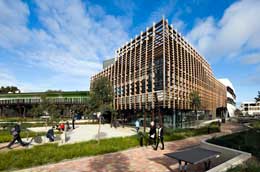06 August 2012
 Minister for Tertiary Education, Skills, Science and Research Senator Chris Evans will officially open the University of South Australia’s new Minerals and Materials Science Building on Monday August 6 at 12.30pm, for the first time showcasing one of the nation’s most advanced research facilities for materials and minerals science.
Minister for Tertiary Education, Skills, Science and Research Senator Chris Evans will officially open the University of South Australia’s new Minerals and Materials Science Building on Monday August 6 at 12.30pm, for the first time showcasing one of the nation’s most advanced research facilities for materials and minerals science.
The vision for the state-of-the-art research facility, affectionately dubbed M2, was realised with a $40 million contribution from the Commonwealth Government’s Education Investment Fund and a further $5 million from the South Australian Government which was matched by the University.
It will be home to 120 research students and staff from Australia and countries around the globe and will be the setting for teaching and learning in the University’s new Bachelor of Science (Advanced Materials).
University of South Australia Vice Chancellor, Professor Peter Høj, says the opening of M2 completes a suite of new developments at Mawson Lakes that will underpin the future of world class research into nanotechnology, and materials and minerals science in SA.
“This new facility at Mawson Lakes campus consolidates what is emerging as one of Australia’s leading science research and education precincts,” Professor Høj says.
“It will be a beacon for students, researchers and industry leaders in the sciences and will make an enormous contribution to new technologies in health, engineering and manufacturing, mining and materials.”
Key areas of research include projects using nanotechnology that aim to support improved detection and treatment of cancers; novel bacteria-resistant coatings for human implants derived from Australian native plant species; thin film technologies to be used in manufacturing to develop harder-wearing and better adapted plastics; wound and water care treatments involving nanotechnology; and the development of microfluidic technologies set to deliver millions in savings to the mining and minerals processing industries.
Professor Høj says the completion of the M2 project, along with the construction of the Mawson Institute and the Centre for Environmental Risk Assessment and Remediation in the past few years represents an investment of more than $100 million in advanced science and technology facilities.
“Strong support from both Federal and State government has played an important role in that development and I think they understand, more than ever, that the contribution universities make to successful societies is unquestionable,” Prof Høj said.
“At Mawson Lakes we are educating the chemists, engineers, bio and nano scientists that will lead future innovation. We are also forging the links and relationships with industry that are so important to that innovation.
“Facilities such as M2 make that kind of collaboration and innovation not only more possible, but more likely.
“In partnership with industry we’re working on solutions to real world industry problems and delivering the improvements that count.”
The University of South Australia is involved in 12 Cooperative Research Centres (CRC) and through that involvement is ranked second in Australia for funding received through the Federal Government’s CRC programs.
“We’re also proud of the quality of the research we deliver,” Prof Høj said.
“The most recent Excellence in Research for Australia assessment showed that research emanating from the Ian Wark Research Centre and the Mawson Institute, which will be based in this new facility, ranked among the very best in the world.”
Key environmental and design features of the building include:
- In July 2012 M2 was named winner of the prestigious Jack McDonnell Award at the 2012 SA Architecture Awards.
- The building was designed by John Wardle Architects + Swanbury Penglase with Hansen Yuncken as managing contractors.
- It features 10 purpose-built laboratories across three levels of the building which have been designed to be visually accessible with glass frontages.
- An oval-shaped studio, acoustically designed to allow lecturers and speakers to talk from the centre of the room and move about the theatre, is a key feature of the ground floor of the building. The theatre has six HD projectors with edge blending technology, a document camera (the modern translation of a white board) and a control room to enable access grid functionality providing capability for regular audio visual presentations but also multimedia large-format displays and interactive group presentations.
- Purpose-built experiential learning studios and demonstration rooms for both first year and fourth year students employ sophisticated technologies that allow collaborative work at the highest level and include options for interface with laboratory experiments in real time.
- The building also has a technology transfer node where collaboration with industry can be undertaken over a few days or for up to six months at a time in a secure enclave within the building.
- The building has a five star green star rating for both Design and As Built ratings.
- Green features include five different mechanical air conditioning systems designed to meet specific performance requirements in different areas of the building; chilled beam systems; solar panels; movement and light level controls to minimise power waste; “green star performance” furniture; and the use of recycled timber, and rubber in flooring.
- In July 2012 M2 was named winner of the prestigious Jack McDonnell Award at the 2012 SA Architecture Awards.
A live stream of the launch of the new Centre will be active on the day from 12.30 pm CST here. Full coverage of the event will be loaded to this site after the event.
Media contact
Michèle Nardelli office: 08 8302 0966 mobile: 0418 823 673 email: michele.nardelli@unisa.edu.au



